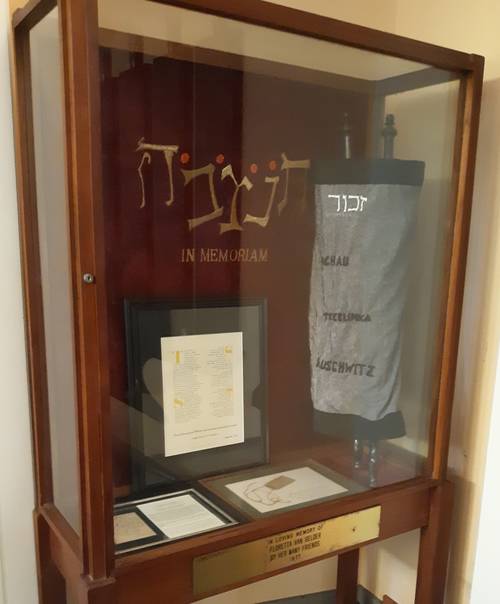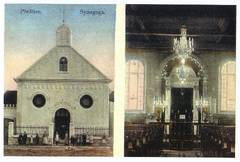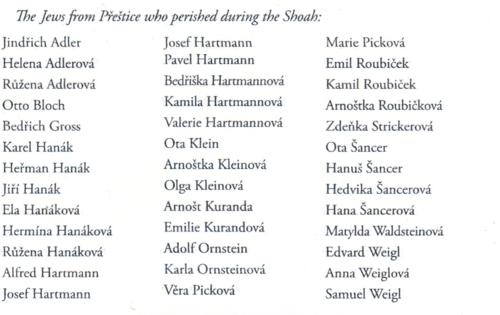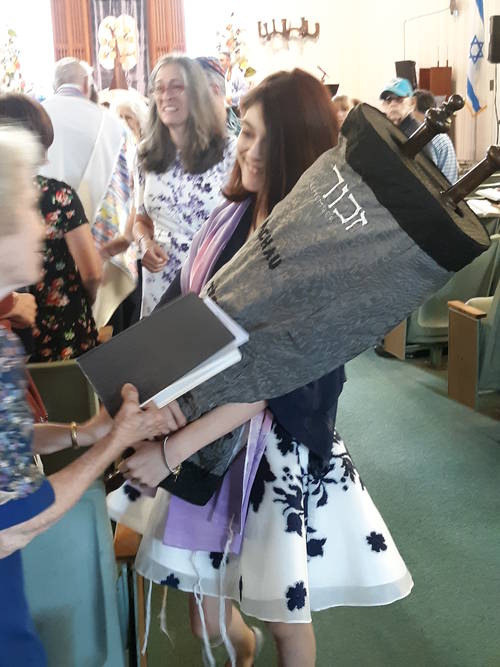A History of Jews in Hawaii
The first mention of Jews in connection with Hawaii was in 1798, when a sailor on the whaling ship Neptune recorded in the ships log that the Hawaiian king had come aboard and brought a "Jew cook" with him! Jewish merchants began arriving in Hawaii between 1850-1900 and established themselves as suppliers to the sugar plantations, as well as owners of coffee plantations. A Torah which had been given to King Kalakaua in the 1880s was frequently borrowed from the Kawananakoa family for use in services into the 1930s.
In 1901, forty Honolulu residents formed the first Jewish congregation, the Hebrew Congregation of Hawaii. Noted Rabbi Rudolf Isaac Coffee of Oakland, California officiated at its founding ceremonies. The HCH established the first Jewish cemetery in Hawaii, but the group itself only lasted about six years. After World War I the Jewish Welfare Board sent Alexander and Jennie Linczer to establish a JWB Center in their home. They were later joined by Max Goldman and the Usheroff family as leaders of the Jewish community. The origins of an organized Temple Emanu-El date back to 1938 when 35 Jewish families on Oahu formed the Honolulu Jewish Community.
In 1939, in cooperation with the Jewish Welfare Board, a small chapel on Young Street was leased and converted into a Jewish Community Center (JCC), which also served as Honolulu's first synagogue building. During World War II, the JCC continued as the focal point of the Jewish community with religious services conducted by military chaplains stationed in Hawaii. In 1942 the Honolulu Jewish Community established a new Hebrew Burial Society and consecrated a section of the O'ahu Cemetery in Nu'uanu for use as a Jewish cemetery. Wartime expansion of Hickam Field necessitated a runway extension over the earlier burial ground and the initial Jewish burials were reinterred at Nu'uanu.
In 1947, the Jewish Welfare Board sent Rabbi Emanuel Kumin to Hawaii to serve as its director. The Honolulu Jewish Community also hired him to serve the congregation on a part-time basis. A temple Sisterhood was organized, and a religious school was begun.The 1950-51 Board adopted the Temple Emanu-El name and purchased the large Frank E Midkiff residence on Oahu Ave, near the University of Hawaii, and consecrated it as the Temple's first home. Rabbi Francis Hevesi, son of the former Chief Rabbi of Budapest, Hungary became the Temple's first full rabbi and on February 11th, 1953, they affiliated with the Union of American Hebrew Congregations (now the Union for Reform Judaism). By the late 1950s, the Temple had outgrown its facilities. It purchased the Castle House property on Nu'uanu Ave (the Pali Highway) and, in 1960, built the present Sanctuary structure (the first original synagogue ever built in Hawaii).
The Kalakaua Torah Scroll

This Sefer Torah (Pentateuch) and Yad (pointer) were brought to Hawaii in 1886 by Elias Abraham Rosenberg who came here from San Francisco.His tombstone in Colma, California prefixes his name with a Hebrew "resh", indicating he was either an ordained rabbi or scholar. He appears to have intrigued King David Kalakaua and became a royal soothsayer and confidant, preparing horoscopes
When Rosenberg journeyed to San Francisco in 1887, he left the Torah and Yad with Kalakaua for safekeeping. The pointer and scroll, along with other artifacts of King Kalakaua through his widow, Queen Kapiolani, eventually came into the possession of the Kawananakoa family (descendants of Kaumualii, king of Kauai). From the early 1900's into the 1930's--the times are uncertain -- the family graciously lent the scroll from time to time to the Jewish community for High Holy Day services. Passing from her grandmother, Princess Abigail Campbell Kawananakoa (1882-1945), the pointer came into the possession of Princess Abigail Kekuaulike Kawananakoa.
In 1960, an emissary of Princess Abigail delivered the Yad into the possession of Rabbi Roy Rosenberg of Temple Emanu-El. At the Temple Emanu-El dedication, on May 29, 1960, Rabbi Rosenberg dedicated the pointer to the Temple. Subsequently, in 1972, the Kalakaua Torah was donated to Temple Emanu-El through the Flora Allen Kaai Hayes family of ali'i descendants.
When temple Rabbi Julius Nodel and Professor Jacob O. Adler received the Scroll, they researched and confirmed that it was, indeed, the long sought Kalakaua Torah. The parchment manuscript was then mounted to a set of Eitz Hayim (rollers) and placed with its original Yad in an especially crafted koa display cabinet in the Sanctuary, where it is now exhibited.
( LSt 2017 )
 The Prestice Torah
The Prestice Torah
WE REMEMBER
Temple Emanu-El- Honolulu is honored by the presence of a Torah rescued from the “new” synagogue (1910) of Prestice, Bohemia during WWII.
The Jewish presence at Prentice dates to the 15th Century; at its 1800s height, about seven hundred and fifty Jews lived in the locality, but both emigration and movement to cities had reduced the number to about 300 by 1930. Prestice, itself, had a population of about a hundred Jews with an additional one hundred twenty-five living in the surrounding region. Prestice, the focal point of the region, was surrounded by seven small, satellite Jewish communities: the central Prestice synagogue served as its regional religious center.
(Pictured right: Prestice Torah-Temple Emanu-El Sanctuary)
 After WW1, the Austro-Hungarian Empire dissolved and a Czecho-Slovak Republic, incorporating Bohemia and Moravia, formed (1918). The 1938 German Anschluss of Austria, foretold that Czechoslovakia’s days were numbered. Nazi Germany began its rule by creation of a “Protectorate of Bohemia & Moravia” in March 1939; this brought numerous anti-Semitic decrees limiting Jewish life and business. The German occupation of the Czech Republic foreshadowed desperate days of upheaval to its Jewish population. (Pictured left: the New Synagogue (1910) Prestice, Bohemia)
After WW1, the Austro-Hungarian Empire dissolved and a Czecho-Slovak Republic, incorporating Bohemia and Moravia, formed (1918). The 1938 German Anschluss of Austria, foretold that Czechoslovakia’s days were numbered. Nazi Germany began its rule by creation of a “Protectorate of Bohemia & Moravia” in March 1939; this brought numerous anti-Semitic decrees limiting Jewish life and business. The German occupation of the Czech Republic foreshadowed desperate days of upheaval to its Jewish population. (Pictured left: the New Synagogue (1910) Prestice, Bohemia)
In better times, an era marked by “modern” city growth, the Jewish Museum of Prague was established (1906). As areas of the ancient, walled,Jewish ghetto were razed into a planned, more open city, the Jewish Museum gathered artifacts. The relics of a myriad of early Prague synagogues were incorporated into a central collection. Decades later, under the German occupation, the Museum’s name changed; now called the Central Jewish Museum, its function was essentially the same …protecting Jewish heritage, but within a morbid context... destruction of Jewry.
Beginning in 1941, Jewish communities in Bohemia & Moravia were disbanded. Jews were systematically expelled to concentration (and, later, extermination) camps. Jews could take little more than a single suitcase of personal items with them. Torah scrolls, scroll binders, prayer books, learned texts, and liturgical items were left behind. The culture of Czech Jewry was abandoned and remained in empty, unguarded community synagogues.
The renamed Central Museum began a new mission …collecting and archiving the religious remnants of Czech Jewish life. In Bohemia, the Prestice Central Synagogue collected & sheltered fourteen, locally-gathered, Torah scrolls. Jewish Life ended in Prestice on November 26th 1942. The last 41 remaining Jews were transported to the Terezin concentration camp by rail.
We Honor and Remember

(Pictured above: The Final Transport from Prestice, Bohemia)
The end of WWII, a 1948 Communist coup resulted in a weak Czech government and non-existent economy. Funding for museum purposes was absent: the state-controlled government relegated the Torah collection to being warehoused in an unheated, 16th Century synagogue in Prague’s Michle district. By the 1960s, with few Jews having survived the Nazis, and being hard pressed for operating money, the Czech Communist regime decided to locate a purchaser for the collection.
An American-born, British art collector, traveling the Continent to stock his London gallery, was approached by the Czech Cultural agency.
They asked if, instead of collecting individual art works, he might be interested in a mass purchase of the Judaica collection… All for £30,000 (about $83,000 US).
A Hebrew scholar sent to Prague to assess the collection, entered the slowly deteriorating Michle Synagogue to survey its contents. He began evaluating a stacked accumulation of parchment scrolls, embroidered mantles, and religious ephemera. The moldering building housed a cultural treasure of Middle European Jewish life. Simple cloth torah binders when unrolled revealed hand-embroidered Hebrew messages celebrating the birth and naming of individual children. Slips of paper found rolled into the scrolls contained sad last messages and prayers of Bohemian Jewry. The Sifrei Torah bore mute testimony to German violence … individual scrolls displayed bayonet holes, slashes, blood, and desecrating stains.
After authentication, the dealer discovered Ralph Yablon, a British philanthropist, willing to fund and complete the transaction.
The precious collection was carefully repacked to withstand shipment by truck and rail to England. In February 1964, one thousand, five hundred, and sixty-four arrived at the Westminster Synagogue, London.
Temple Emanu-El Fulfills: Zachor - (“Remember”)
A custom-crafted mantle for the Prestice Torah was designed and created by Joey Silver of Honolulu and Jerusalem. The cover fabric is a fine silk chosen at a Jerusalem silk merchant’s shop; the color selected corresponds to the “Feldgrau” of German WWII uniforms. Heavy, rubberized black thread was incorporated to mimic the stitching in military jackboot construction. A silver embroidered “Zachor” (“remember” in Hebrew) stands above the names of three notorious Nazi “Konzentrationslagers” in black: Dachau, Treblinka, and Auschwitz. The names are placed offset to lend an air of discord to their presentation. Embroidered on the mantle’s reverse is Joey Silver’s personal dedication to the “Almost seven million Jewish victims and half a million homosexual victims of the Holocaust”.
During several Honolulu community ceremonies and yearly Yom HaShoah memorials, Temple Emanu-El has hosted members and descendents of the most-highly-decorated unit of WWII… the US Army’s Japanese 442nd Regimental Combat Team. In April 1945, the artillery unit of the Army’s most-highly-decorated 442nd participated in the liberation of Dachau. (Pictured right: Bat Mitzvah of Isabella Guren, 2019)
( LSt 2019)
